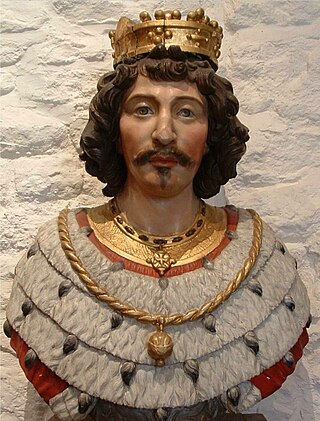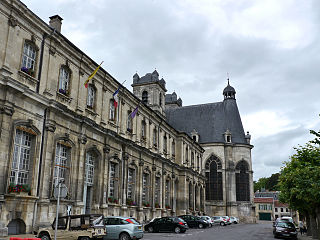
Soignies is a municipality of Wallonia located in the province of Hainaut, Belgium.

The Archdiocese of Cambrai is a Latin Church ecclesiastical jurisdiction or archdiocese of the Catholic Church in France, comprising the arrondissements of Avesnes-sur-Helpe, Cambrai, Douai, and Valenciennes within the département of Nord, in the region of Nord-Pas-de-Calais. The current archbishop is Vincent Dollmann, appointed in August 2018. Since 2008 the archdiocese has been a suffragan of the Archdiocese of Lille.

Vincent Madelgarius, aka Maelceadar, Benedictine monk, died 677. His feast day is September 20.

Lobbes Abbey was a Benedictine monastery in the municipality of Lobbes, Hainaut, Belgium. The abbey played an important role in the religious, political and religious life of the Prince-Bishopric of Liège, especially around the year 1000. The abbey's founding saint is Saint Landelin; four other saints are also connected with the abbey.

Saint-Mihiel Abbey is an ancient Benedictine abbey situated in the town of Saint-Mihiel, near Verdun in the Meuse department in Lorraine in north-eastern France.

Bassac Abbey is a former Benedictine monastery in Bassac, Charente, France, in the former diocese of Saintes.

The Abbey of Saint-Seine is a former Benedictine monastery located in Saint-Seine-l'Abbaye, Côte-d'Or, Burgundy, France. During the Middle Ages it was a wealthy and powerful institution. It was suppressed at the French Revolution.

The Abbey of Saint-Symphorien or St Symphorian's Abbey is a former Benedictine monastery founded by Saint Papoul, bishop of Metz, in 609. It was the first Benedictine abbey for men built in Austrasia.

Beaugerais Abbey is a former Cistercian abbey, located in what is now the commune of Loché-sur-Indrois, in the Indre-et-Loire département of France.
Saint Bertille of Thuringia(French: Sainte Bertille de Thuringe or also known as Saint Bertilla, the daughter of Bercarius, King of Thuringia, was a Merovingian princess and Frankish saint who resided in the County of Hainaut in Belgium. Bertille was the mother of Saint Waltrude and Saint Aldegund, foundress of Maubeuge Abbey.
Saint Walbert IV(French: Sainte Walbert IV), also known as Vaubert, Waubert, or Waudbert was a Merovingian Count of Hainaut and a Frankish saint. He was the father of Saint Waltrude, and Saint Aldegund, first abbess of Maubeuge.
Walbert II also called the Younger, was a patrician, Roman senator, and Merovingian Count of Haynau and of the Ardennes.
Hydulphe, Hydulphus, Hidulphe, Hidulf, commonly known as Hydulphe of Lobbes(French: Hydulphe de Lobbes) was a Frankish saint who helped Saint Landelin establish Lobbes Abbey, Crespin Abbey, and Aulne Abbey.
Walbert III was a Frankish nobleman and a Merovingian Count.

Landry, Landric, Landericus, or Landry of Soignies, commonly known as Saint Landry of Metz was a Roman Catholic Bishop of Metz, Benedictine abbot of Haumont and Soignies, and a Frankish saint. He was the son of Saint Waltrude and Madelgaire.

Dentelin, Dentelinus, or Saint Dentelin of Soignies was a Frankish saint. He was the son of Saint Waltrude and Madelgaire.

Collegiate Church of Saint-Vincent de Soignies or Saint-Vincent Collegiate Church of Soignies is a church located in Soignies, Hainaut Province in Belgium.













